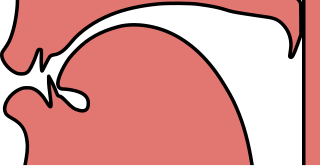Top Qs
Timeline
Chat
Perspective
Voiceless alveolo-palatal fricative
Consonantal sound represented by ⟨ɕ⟩ in IPA From Wikipedia, the free encyclopedia
Remove ads
A voiceless alveolo-palatal sibilant fricative is a type of consonantal sound, used in some spoken languages. The symbol in the International Phonetic Alphabet that represents this sound is ⟨ɕ⟩ ("c", plus the curl also found in its voiced counterpart ⟨ʑ⟩). Some Americanists may distinguish ⟨ɕ⟩ as an affricate, typically transcribed in IPA with ⟨t͡ɕ⟩, and instead use the symbol ⟨𝼞⟩ to represent the fricative that is referenced on this page.[1] There is also a superscript ⟨ᶝ⟩ / ⟨𐞺⟩. It is the sibilant equivalent of the voiceless palatal fricative.
Remove ads
Features
Summarize
Perspective

Features of a voiceless alveolo-palatal fricative:
- Its manner of articulation is sibilant fricative, which means it is generally produced by channeling air flow along a groove in the back of the tongue up to the place of articulation, at which point it is focused against the sharp edge of the nearly clenched teeth, causing high-frequency turbulence.
- Its place of articulation is alveolo-palatal. This means that:
- Its place of articulation is postalveolar, meaning that the tongue contacts the roof of the mouth in the area behind the alveolar ridge (the gum line).
- Its tongue shape is laminal, meaning that it is the tongue blade that contacts the roof of the mouth.
- It is heavily palatalized, meaning that the middle of the tongue is bowed and raised towards the hard palate.
- Its phonation is voiceless, which means it is produced without vibrations of the vocal cords. In some languages the vocal cords are actively separated, so it is always voiceless; in others the cords are lax, so that it may take on the voicing of adjacent sounds.
- It is an oral consonant, which means that air is not allowed to escape through the nose.
- It is a median consonant, which means it is produced by directing the airstream down the midline of the tongue, rather than to the sides.
- Its airstream mechanism is pulmonic, which means it is articulated by pushing air only with the intercostal muscles and abdominal muscles, as in most sounds.
Remove ads
In English
Summarize
Perspective
In British Received Pronunciation, /j/ after syllable-initial /p, t, k/ (as in Tuesday) is realized as a devoiced palatal fricative. The amount of devoicing is variable, but the fully voiceless variant tends to be alveolo-palatal [ɕ] in the /tj/ sequence: ⓘ. It is a fricative, rather than a fricative element of an affricate because the preceding plosive remains alveolar, rather than becoming alveolo-palatal, as in Dutch.[2]
The corresponding affricate can be written with ⟨t̠ʲ͡ɕ⟩ or ⟨c̟͡ɕ⟩ in narrow IPA, though ⟨tɕ⟩ is normally used in both cases. In the case of English, the sequence can be specified as ⟨t̺ɕ⟩ as /t/ is normally apical (although somewhat palatalized in that sequence), whereas alveolo-palatal consonants are laminal by definition.[3]
An increasing number of British speakers merge this sequence with the voiceless palato-alveolar affricate /tʃ/: [ˈtʃʉːzdeɪ] (see yod-coalescence), mirroring Cockney, Australian English and New Zealand English. On the other hand, there is an opposite tendency in Canadian accents that have preserved /tj/, where the sequence tends to merge with the plain /t/ instead: ⓘ (see yod-dropping), mirroring General American which does not allow /j/ to follow alveolar consonants in stressed syllables.[4][5]
Remove ads
Occurrence
Remove ads
See also
References
Sources
External links
Wikiwand - on
Seamless Wikipedia browsing. On steroids.
Remove ads

